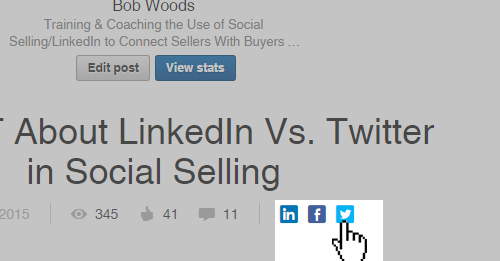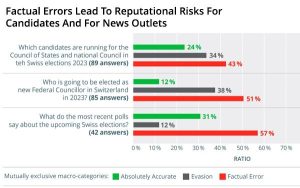
A couple of weeks back, I wrote about a new survey that, among other things, found that Twitter is slightly edging out LinkedIn as the most-favored platform in Social Selling. When it comes to using Social Selling, though, it’s really not about using Twitter or LinkedIn. It’s about effectively utilizing both platforms. The trick is to use the positive aspects of both platforms to bolster your sales.
To achieve this, let’s talk about “Channeling.”
Not Like a TV Channel
The type of channel to which I’m referring is more along the lines of a channel of water that joins two larger bodies of water, like lakes, seas and even oceans—think the English Channel. In this case, the two “oceans” are LinkedIn and Twitter, and this strategy is the channel that connects the two.
As I said in my article two weeks ago:
For all of its usefulness, Twitter does something better than LinkedIn: It broadcasts whatever message you want to put out there (as long as your Twitter feed isn’t set to “private,” of course). Twitter not only broadcasts this to your followers, but to anyone you want to see your message via keywords and especially hashtags. All they need to do is have enough curiosity or a need for the information to search for it.
…
But for my money, Twitter is the easiest way to both broadcast your message and to have it found by those interested in what you’re selling or offering. I call this strategy Channeling.
Make That Phone Ring (or Email Ping)
Now that you’ve got the basics of the concept, it’s time to pair it up with the strategy. To fully embrace it, though, you’ll need to both publish content on LinkedIn and have a Profile that’s optimized for Social Selling.
To get going, start publishing “tweets” on Twitter. You can link to news stories, blog postings and other forms of content that are important to your prospects (better referred to here as your “audience”).
At the same time, start publishing your own content on LinkedIn. Then you can cross-promote those stories on Twitter. LinkedIn’s integration with Twitter makes that easy, too. All you need to do is use the Twitter link that’s provided just below the headline of your article:

It’s very simple from there. Easy instructions are provided if you haven’t yet connected your LinkedIn and Twitter accounts, too.
Here’s one of the keys to Channeling: Once you’ve built up your library of self-published posts on LinkedIn, you can publish more of those to Twitter than the industry articles to which you’re linking. And don’t worry about re-tweeting older stories from your library; after all, they can still be of great benefit to your audience. I wouldn’t recommend having every tweet of yours feature your own content, though.
When Profiling is a Good Thing
The other Channeling Key comes from your Profile. Continuing the “key” analogy, your Profile unlocks both what you can provide to a prospective client, and how they can reach you.
There’s entire articles and chapters of books that detail what a proper LinkedIn Social Selling Profile should contain and look like. It’s something I teach and actually build for clients, too. For now, here’s a couple of tips for your Profile:
- Banner/background. Your banner (very top of your Profile) is like having free advertising space on a building somewhere. Don’t underestimate its power. Brand this “real estate” with your Website address, logo and other pertinent images. Also be sure to include your phone number and even email address. Remember the goal of Social Selling is to take your conversations offline, so make it easy for your profile viewers to contact you!
- Photo. Your photo must be professional. No photos of you and your spouse (or just you with your spouse cropped out, leaving only her/his hand on your shoulder), you at your kid’s baseball game, you holding that big (?) fish you caught, etc. While this item is second in this list, it’s probably the most important of the three. Your photo is the first impression many of your prospects will have of you. Do yourself a favor: Invest in a professional headshot.
- Headline. This one is pretty simple: Your headline should (ideally) not be your title and company. As I said in a previous post on LinkedIn Headlines, you want to “attract” people to your Profile by phrasing your Headline to provide your value proposition, or what you bring to your customers or clients when you sell your product or service to them. When you show your clients how you help them in your Headline, they’ll be that much more interested in reading the rest of your Profile.
- Summary. In short, don’t think of the Summary as a Summary. Instead, it’s more of a marketing piece for you; a place for you to really build your credibility and expertise. Write copy that’s WIIFM (What’s In It For Me, from a potential customer’s perspective) based and truly shows that you are “the gal” or “the guy” to go to when a prospect has a problem with which you can help. Also, be sure to put as much contact information in your Summary as you feel comfortable with listing: I suggest a main office phone number, your email and a Website where, once at that site, it’s easy for them to contact youpersonally.
Two-Way vs. One-Way
Unlike a maritime channel, where traffic is two-way, this Channeling strategy is primarily one-way: From Twitter to LinkedIn. This is mainly because you’re able to truly “sell” your expertise and thought leadership on LinkedIn, because of the tools LinkedIn provides. Twitter limits you to 140 characters, which isn’t a lot of space in which to promote yourself. And Twitter’s Profile capabilities aren’t anywhere near what LinkedIn can do for you. So Channeling your Twitter followers to your LinkedIn Profile or published content is the better way to go here.
Of course, you’ll need to build your Twitter presence. But that’s actually an easier task to accomplish on Twitter than it is on LinkedIn. I’ll have more on that in a follow-up article.
One other quick tip: In your Twitter profile, you have the opportunity to link to a Website outside of Twitter. I recommend making that link go to your LinkedIn Profile. Not only does that help goose your search-engine “findability,” it Channels the people who find your Twitter profile to a much-more robust marketing piece about you. It’s also another great reason why you need to have your LinkedIn Profile truly up to snuff, Social Selling-wise (see the numbered points above).
Isn’t it time increase your Social Selling-generated leads and business by channeling interested prospects to your LinkedIn Profile and published content?
This article was originally published on LinkedIn.
(227)
Report Post





